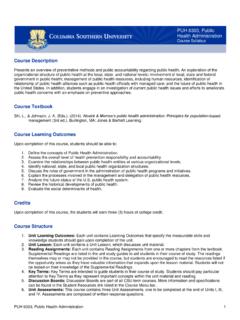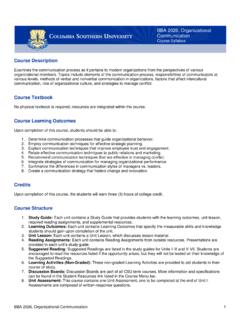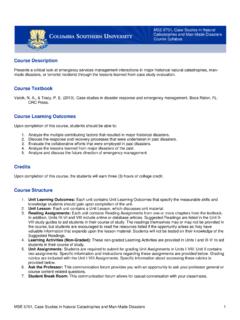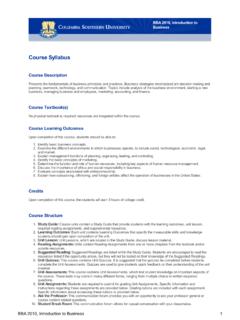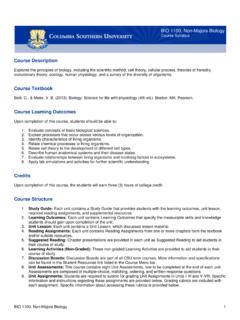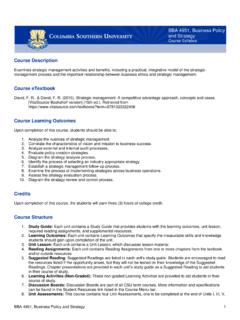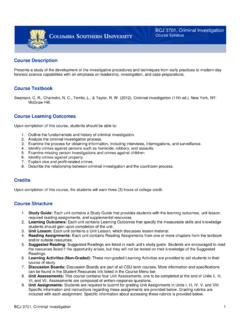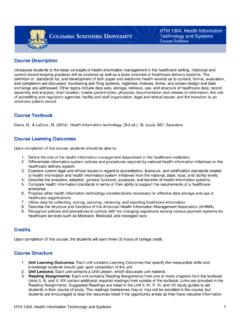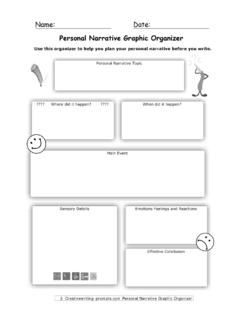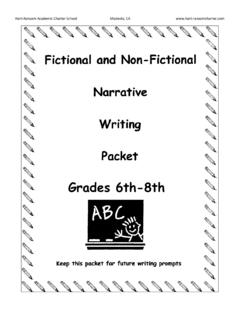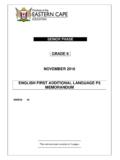Transcription of Course Description Course Textbook - Login
1 FIR 3307, Community Risk Reduction for the Fire and Emergency Services 1 Course Description Provides an overview of the comprehensive approach to fire prevention within the community. Covers strategic planning and community programs as they relate to fire safety prevention and terrorist incidents. Explores the plan review process, code development, code enforcement, fire investigation, and evaluating prevention programs. Course Textbook Shaw, R. (Ed.). (2012). Community-based disaster risk reduction (Vol. 10). Bingley, England: Emerald. Course Learning Outcomes Upon completion of this Course , students should be able to: 1. Become champions of risk reduction. 2. Develop and meet risk reduction objectives.
2 3. Identify and develop intervention strategies. 4. Implement a risk reduction program. 5. Review and modify risk reduction programs. Credits Upon completion of this Course , the students will earn three (3) hours of college credit. Course Structure 1. Unit Learning Outcomes: Each unit contains Learning Outcomes that specify the measurable skills and knowledge students should gain upon completion of the unit. 2. Unit Lesson: Each unit contains a Unit Lesson, which discusses unit material. 3. Reading Assignments: Units I-V, VII, and VIII contain Reading Assignments from one or more chapters from the Textbook . A Suggested Reading is listed in the Unit VII study guide. The reading itself is not provided in the Course , but students are encouraged to read the resource listed if the opportunity arises as it has valuable information that expands upon the lesson material.
3 4. Key Terms: Key Terms are intended to guide students in their Course of study. Students should pay particular attention to Key Terms as they represent important concepts within the unit material and reading. 5. Unit Assignments: Students are required to submit for grading Unit Assignments in each unit. Specific information and instructions regarding these assignments are provided below. Grading rubrics are included with each Assignment. Specific information about accessing these rubrics is provided below. 6. Research Paper: Students are required to submit for grading a Research Paper in Unit VIII. Specific information and instructions regarding this assignment are provided below.
4 A grading rubric is included with this assignment. Specific information for accessing this rubric is included below 7. Ask the Professor: This communication forum provides you with an opportunity to ask your professor general or Course content related questions. 8. Student Break Room: This communication forum allows for casual conversation with your classmates. FIR 3307, Community Risk Reduction for the Fire and Emergency Services Course Syllabus FIR 3307, Community Risk Reduction for the Fire and Emergency Services 2 CSU Online Library The CSU Online Library is available to support your courses and programs. The online library includes databases, journals, e-books, and research guides.
5 These resources are always accessible and can be reached through the library webpage. To access the library, log into the myCSU Student Portal, and click on CSU Online Library. You can also access the CSU Online Library from the My Library button on the Course menu for each Course in Blackboard. The CSU Online Library offers several reference services. E-mail and telephone ( ) assistance is available Monday Thursday from 8 am to 5 pm and Friday from 8 am to 3 pm. The library s chat reference service, Ask a Librarian, is available 24/7; look for the chat box on the online library page. Librarians can help you develop your research plan or assist you in finding relevant, appropriate, and timely information.
6 Reference requests can include customized keyword search strategies, links to articles, database help, and other services. Unit Assignments Unit I Assignment Building a Demographic Profile of Your Community Introduction: In this assignment, you will practice using American Fact Finder; create a demographic, social, economic, and housing profile of your community; profile how your community has developed and changed over the past 20 years; and predict what your community may look like 10 years from now. A. Practice Using American Fact Finder 1. Using this website, you will first locate your local jurisdiction by city. Follow the instructions below to access information on your community.
7 2. Go to the Census Bureau Fact Finder website at Type the city and state in the search box for the community you would like to research. B. Build a Demographic Profile of Your Home Community 1. Use American Fact Finder to build a current demographic profile of your home community. Develop a profile of the people who live in your community (age, gender, race, ethnicity, incomes, poverty, etc.). Perform the same actions for housing (type of homes, age, owner versus renter, etc.). Also, explore a profile of employment. A worksheet with prompting questions is provided below to assist you. The demographic information will be used throughout the Course . You must have this information available throughout the Course in order to process the in-class activities and the culminating project for the Course .
8 Saving the information on a memory device or printing hard copies is highly recommended. All American Fact Finder categories can be downloaded or printed. You also may wish to save the Census Bureau website as a favorite on your PC. Explore the Frequently Asked Questions (FAQs) page for American Fact Finder. The link to the page is located on the top right of the American Fact Finder website. 2. Once information has been gathered, consider how your home community has developed over time (past 20 years). Also consider how it may change as time progresses. As part of this assignment, develop a short narrative on how your community has changed over the past 20 years and what its profile might look like 10 years from now.
9 One last huge point to consider: The Census is collected and processed every 10 years. Community demographics can change dramatically in that timeframe. EFOs must remain knowledgeable of their home community's changing demographics. It is wise to have a discussion with your local planning or community development professionals. If you have such a discussion, please include your findings as part of the narrative for this section. Being able to explain and use the demographic, social, and cultural development of your community is essential to the effectiveness and credibility of a strategic decision maker. FIR 3307, Community Risk Reduction for the Fire and Emergency Services 3 Click here to access a PDF of the Demographic Worksheet example.
10 Information about accessing the grading rubric for this assignment is provided below. Unit III Assignment Using your judgment and the information you gathered from previous units, select the three leading hazards in your community and complete the following worksheet for each hazard. Click here to access the Community Hazards worksheet. Complete the worksheet, save it using your last name and student ID, and submit it. Information about accessing the grading rubric for this assignment is provided below. Unit IV Assignment Assess your community's vulnerability for each of the three hazards identified in the Unit III Assignment. It is essential that each area of vulnerability be considered for each hazard.
